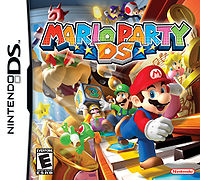| Site Notice |
|---|
|
Difference between revisions of "Mario Party DS"
(Added japanese stuff.) |
|||
| Line 2: | Line 2: | ||
{{Game infobox | {{Game infobox | ||
|title=Mario Party DS | |title=Mario Party DS | ||
| − | |jptitle= | + | |jptitle=マリオパーティDS |
| − | |jptrans=Mario | + | |jptrans=Mario Party DS |
|boxart=MPDS_NACover.jpg | |boxart=MPDS_NACover.jpg | ||
|players=1-4 | |players=1-4 | ||
| Line 21: | Line 21: | ||
|colorscheme=Mario red | |colorscheme=Mario red | ||
}} | }} | ||
| − | '''''Mario Party DS''''' is the eleventh installment in the ''Mario Party'' series, and the thirteenth in Japan. It is the second game released in a portable console; with the first game, ''[[Mario Party Advance]]''. | + | '''''Mario Party DS''''' (Japanese: '''マリオパーティDS''' ''Mario Party DS'') is the eleventh installment in the ''Mario Party'' series, and the thirteenth in Japan. It is the second game released in a portable console; with the first game, ''[[Mario Party Advance]]''. |
==Story== | ==Story== | ||
{{sectionstub}} | {{sectionstub}} | ||
Revision as of 07:51, 28 July 2010
| This article is a short summary of Mario Party DS. Super Mario Wiki features a more in-depth article. |
| Mario Party DS | ||||||||||||||
| マリオパーティDS | ||||||||||||||
| ||||||||||||||
| ||||||||||||||
| ||||||||||||||
| ||||||||||||||
|
Mario Party DS (Japanese: マリオパーティDS Mario Party DS) is the eleventh installment in the Mario Party series, and the thirteenth in Japan. It is the second game released in a portable console; with the first game, Mario Party Advance.
Story
Gameplay
Gameplay remains unchanged prior to the Mario Party series. During gameplay, the game has two types of items: Normal items that can be used on themselves, and a new type of item called Hexes, where players can set a trap by placing one on a nearby space in the board. The majority of the mini-games often utilize the stylus, or microphone, exclusive to the game.
As players ascend into the game more, players can unlock collectibles such as character figurines, board features, boss trophies, and badges by gaining Mario Party Points, winning mini-games, and exploring a variety of ways to play the game. These items can be examined in Gallery Mode.
In Puzzle Mode, there are six mini-games that originated from previous Mario Party series; with five including Mario's Puzzle Party (Mario Party 3), Bob-omb Breakers (Mario Party 4), Piece Out (Mario Party 5), Block Star (Mario Party 6), and Stick and Spin (Mario Party 7), and a new puzzle mini-game called Triangle Twisters, which can be unlocked after beating the final boss of the game.
A major focus in the game is the inclusion of multiplayer gaming - which enables players with Nintendo DS units to wirelessly play Party Mode, and Mini-Game Mode for four players, and Puzzle Mode for two players with a single game card, or multiple game cards.
| This article is a stub. You can help NintendoWiki by expanding it. |
